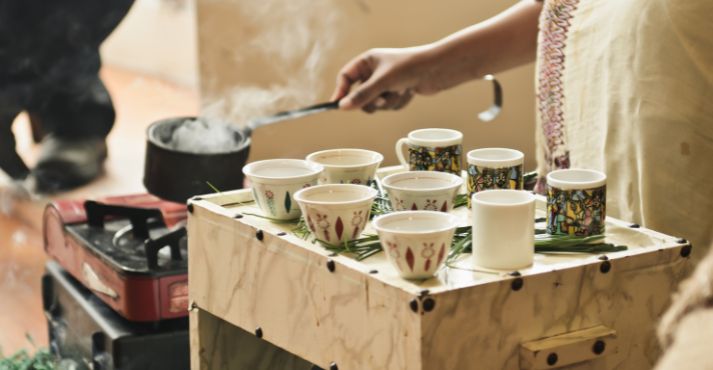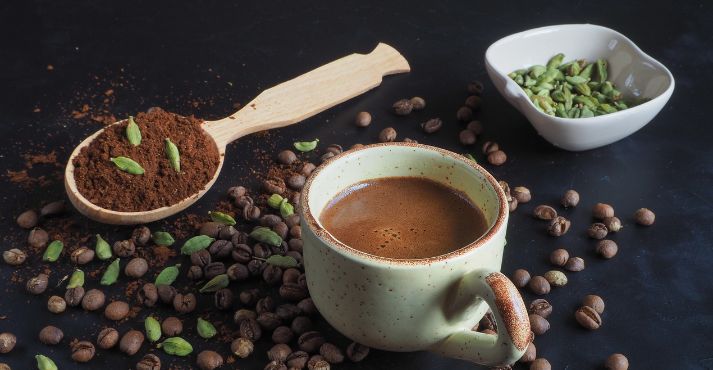Exploring “Coffee Rituals Around the World” is a voyage into the essence of interpersonal relationships, culture, and tradition. Each cup of coffee carries the weight of cultural heritage and provides a window into the mosaic of nearby and distant societies.
While coffee itself may be a universal language, the variety that makes our globe so incredibly rich can be seen in the way it is enjoyed and shared as we move from continent to continent, from tradition to innovation.
Let us delve deeper into the different coffee rituals from around the world.
1. Turkish Coffee Reading: Predict the Future

Turkish coffee reading has been integral to Middle Eastern and Balkan cultures for centuries, allowing individuals to predict fortunes and engage in meaningful conversations.
Rooted in divination traditions, this practice involves interpreting the patterns created by the sediments at the bottom of a cup of Turkish coffee.
Turkish coffee reading is known as “tasseography” or “tasseomancy,” It involves following a particular process:
First, finely ground coffee is boiled with water and sugar to create a thick, concentrated brew. When the coffee has been consumed, its grounds start to settle to the bottom of the cup, resulting in the formation of intricate patterns.
The cup is then inverted onto a saucer to cool, and a reader interprets the shapes and symbols left behind.
Symbolic Insights from Sediments
The shapes, lines, and symbols that emerge from the patterns that are formed by the coffee grounds hold a lot of significance. For example, a ring can represent a wedding, a snake could indicate a hidden challenge, and a tree could symbolize growth and prosperity.
Experienced readers are able to combine these different symbols to craft a cohesive narrative that offers guidance, predictions, and reflections on the querent’s life.
Divination Traditions and Beliefs
It is interesting to note that reading fortunes through coffee grounds is wider than just Turkish culture. Similar traditions are present in different cultures. For example, tea leaf reading (tasseography) in Europe and chai cup reading in the Middle East.
Such practices are a reflection of humanity’s fascination with using ordinary objects to gain extraordinary insights into the future.
Cultural Connection and Conversations
Turkish coffee reading is a special way to promote cross-cultural understanding and have deep exchanges. Following the custom of fortune telling, when friends and family get together for coffee, conversations about hopes, anxieties, and life experiences are frequently facilitated.
People get to know one another better and make enduring memories when they share and interpret fortunes.
Preserving a Centuries-old Tradition
The practice of Turkish coffee reading confronts difficulties in preserving its significance in the fast-paced world of today.
However, there are still efforts being made to keep this practice alive through cultural events, workshops, and internet resources. The younger generation is receiving expertise from enthusiasts, ensuring the practice’s survival.
2. Italian Espresso: The Heart of Daily Life

In Italy, espresso isn’t just a beverage; it’s a cultural phenomenon transcending the boundaries of taste and time. The Italian espresso culture is a fascinating blend of caffeine elegance, espresso moments, and warm hospitality.
The Essence of Italian Espresso
When we talk about Italian espresso, it is important to remember that it is a concentrated shot of tradition, craftsmanship, and artistry.
This energizing beverage is made by squeezing hot water through finely-ground coffee beans, and it has a strong flavor that arouses the senses. Each sip is evidence of the great attention put into making this traditional brew.
Daily Rituals and Espresso Moments
As an Italian, your day starts with a mandatory visit to a local cafe for an espresso. This morning espresso is a meditation of sorts, a pause before the hectic day ahead unfolds and not just a caffeine intake.
Throughout the day, espresso becomes a punctuation mark, a quick pick-me-up to refuel and recharge. These espresso moments are brief yet powerful, allowing individuals to savor the present and gather their thoughts.
Italian Hospitality and Espresso Culture
The culture of espresso and Italian hospitality dance together in a beautiful way. Bringing someone a cup of coffee, usually an espresso, is a friendly gesture.
Sharing an espresso strengthens relationships and forges enduring memories, whether it’s catching up with an old friend or concluding a commercial deal. Coffee breaks are treasured as chances to connect, chat, and appreciate life’s basic joys.
Caffeine Elegance and Aesthetic Appeal
When it comes to coffee, it is the aesthetic, elegance, and sensory experience that holds a lot of importance almost as much as the flavor of the espresso. The aesthetic and sensory experience are just as important to espresso’s elegance as its flavor.
A perfectly made espresso with a thick crema can be intriguing to look at. Every espresso ritual includes the act of holding the little cup, feeling its warmth, and inhaling the aromatic mist, all of which add to the sensory delight.
Preserving Tradition in Modern Times
Italy is unwavering in its dedication to the craft of espresso in the face of shifting lifestyles and the emergence of the to-go coffee culture. Many Italians still favor quality over practicality, preferring to linger at the café bar as opposed to rushing with a takeout cup.
This commitment to upholding the integrity of espresso culture is a reflection of how closely associated espresso is with Italian identity.
3. Ethiopian Coffee Ceremony: Bonding Through Buna

The Ethiopian coffee ceremony is known as “Buna,”. It is considered to be a sacred tradition that stands for community, unity, and cultural heritage, making it beyond the mere consumption of coffee.
This ceremony entails roasting, brewing, and then sharing coffee. Let us now look at these Ethiopian cultural ceremonies in more detail.
The Essence of the Buna Tradition
As we discussed earlier, the Buna tradition showcases Ethiopia’s cultural richness and emphasizes the idea of togetherness and sharing as a community.
Each step, from roasting the green coffee beans to brewing the perfect cup, is an intentional act that pays homage to tradition.
Ritualistic Brews and Cultural Significance
It is fascinating to note that this Ethiopian coffee ceremony is also a sensory journey of sorts. This is because it involves the senses of sight, smell, taste, and touch.
The first step releases an aroma that seduces the senses by roasting the coffee beans. Next, beans are mashed and brewed in a traditional vessel called a “jebena.”
Pouring and serving coffee is a sign of respect and hospitality that emphasizes the value of relationships with the local community.
Community Bonding and Coffee Fellowship
The Buna tradition stands as the foundation of Ethiopian social life, and it creates an atmosphere of unity by allowing individuals from all walks of life to come together and share their stories, aspirations, and laughter while they drink freshly brewed coffee.
This act of togetherness reminds people of their rich shared cultural heritage and helps foster a sense of pride as well.
Preserving Tradition Amidst Modernity
While the world around them continues to change rapidly, the Ethiopian coffee ceremony stands still as a symbol of tradition and community.
Continuous efforts are put in to ensure the preservation of this sacred ritual. This is done through planning cultural festivals, family gatherings, and community events.
As younger generations learn the art of the ceremony from their elders, the torch of cultural unity continues to be passed down.
4. Vietnamese Egg Coffee: A Sweet Surprise

If you are in Vietnam and you want a unique coffee experience, there lies in their vibrant streets the Vietnamese egg coffee.
This charming concoction brings together the world of coffee and egg yolks, resulting in a velvety and indulgent beverage that has captured the hearts of coffee enthusiasts.
A Fusion of Flavors
The Vietnamese egg coffee is made through the marriage of the rich notes of coffee with the creamy texture of egg yolks.
This coffee accurately demonstrates the innovative spirit of Vietnamese cuisine, where many unusual and innovative culinary combinations are used to create delightful surprises for the taste buds.
Egg-Enhanced Brews
The creation of Vietnamese coffee is an art form in itself. Whisked egg yolks are combined with sweetened condensed milk, resulting in a luscious, frothy mixture.
This creamy concoction is then poured over a cup of strong Vietnamese coffee, often brewed using a drip filter.
The result is a layered masterpiece where the sweet, silky egg mixture beautifully counterbalances the coffee’s bitterness.
Cultural Connection and Coffee Fusion
Vietnamese egg coffee represents the cultural resourcefulness and inventiveness of the Vietnamese people. It goes beyond the taste.
This perfect mingling of flavors between old and new signifies tradition and innovation. It also demonstrates how successful culinary experimentation can result in the development of cherished culinary customs.
Preserving Tradition in Modern Times
It is extremely interesting to note that as Vietnam is modernizing, a very traditional practice, such as egg coffee, has started to find its place in contemporary culture.
You will now witness many cafés across Vietnam serving this beloved beverage, often with their unique twists. This allows both locals and visitors to indulge in a taste of the past while embracing the present.
5. Middle Eastern Cardamom Coffee: Aromatic Harmony

The practice of infusing coffee with cardamom is a centuries-old tradition in the Middle Eastern coffee culture.
This aromatic tradition is a testament to the region’s rich heritage, where the addition of cardamom to coffee brings forth a symphony of flavors. Let us explore this further:
The Art of Spiced Harmony
Cardamom is often called the “Queen of Spices.” It is extremely special in Middle Eastern cuisine.
When introduced to coffee, its warm, citrusy, and slightly herbal notes blend seamlessly with its deep and bold profile. This harmonious combination adds layers of complexity, making each sip an exploration of flavors.
A Reflection of Cultural Warmth
In the Middle East, coffee is a symbol of hospitality and community. The addition of cardamom takes this tradition a step further. The aromatic brew invites people to gather, share stories, and engage in meaningful conversations.
This gesture of offering cardamom-infused coffee also reflects the region’s warmth and welcoming nature of its people.
Flavored Elegance
Coffee with cardamom in it is more than just a culinary preference—it’s a statement.
Every sip of coffee becomes a moment of sophisticated delight thanks to cardamom’s deep, earthy aroma. This one ingredient transforms a simple cup of coffee into a retreat by the gentle spice that dances in the mouth.
Preserving Heritage Through Flavor
As cultures evolve, the tradition of cardamom-infused coffee remains a cherished part of Middle Eastern heritage.
While modern coffee culture embraces diverse flavors, this practice preserves the essence of traditional hospitality. Cafés, homes, and gatherings continue to honor the art of combining cardamom and coffee, ensuring that this centuries-old practice remains alive.
6. Japanese Siphon Brewing: Precision and Aesthetics

In the world of coffee, Japanese siphon brewing stands as a testament to the delicate dance between precision and aesthetics.
This intricate method of brewing transcends the realms of mere coffee preparation, transforming into a captivating performance that engages both the senses and the spirit.
The Elegance of Brewing
Japanese siphon brewing is a symphony of precision and elegance. The process begins with setting up a complex apparatus that involves two chambers, a heat source, and a vacuum effect.
The brewing method demands careful attention to measurements, water temperature, and timing. As the brewing process unfolds, it becomes a performance that marries science with artistry.
Siphon Mastery
Brewing a Japanese siphon requires a lot of skill and precision.
The exact measurement of coffee grounds, the control of water temperature, and the exact timing of each step are essential to achieving a perfect cup. This mastery of the siphon technique results in a brew embodying the coffee beans’ pure essence.
Artful Infusion
The aesthetic experience of Japanese siphon brewing transcends its mechanical intricacy. The brewing procedure resembles a choreographed dance as the water rises from the lower chamber to meet the coffee grinds.
Brewing is transformed into an artistic endeavor by the enticing mist, soft bubbling, and visual spectacle.
The Aesthetic Connection
Japanese siphon brewing creates a special bond between the brewer and the consumer. Every sip reveals the accuracy and care put into the process.
The coffee pouring from the upper chamber represents the achievement of the brewer’s perseverance and the drinker’s anticipation. A link is formed by this shared experience that transcends the cup.
7. Brazilian Cafezinho: Small Cup, Big Tradition
In the vibrant tapestry of Brazilian culture, a humble cup of coffee known as “cafezinho” weaves together threads of conviviality, social connections, and heartfelt hospitality.
This small, strong cup of coffee transcends its role as a mere beverage, becoming a symbol of togetherness and warm gestures.
The Cafezinho Ritual
Cafezinho is more than just a beverage; it is a ritual carrying a sense of community with it. Cafezinto invites you to pause, converse, and connect at home, work, or a local cafe.
It’s a tradition that reinforces the Brazilian value of gathering and embracing the beauty of shared moments.
Community Sips
Cafezinho is usually served in small cups, which encourages frequent sips and conversations. People drinking this together end up sharing stories, laughter, and heart-to-heart talks. Therefore, Cafezinho serves as a bridge that brings people together.
Warm Gestures and Coffee Friendship
In Brazilian culture, offering cafezinho is a sign of friendliness and hospitality. It’s a way to be hospitable and considerate to visitors or friends. Serving cafezinho offers an invitation to friendship and companionship, whether by opening your home to someone or having a short cup at a neighborhood cafe.
Cafezinho in Daily Life
Brazil’s everyday existence is now inextricably entwined with cafezinho. It is a constant companion during breaks at work, an important component of family get-togethers, and a mainstay in social situations.
Everybody is reminded of the delight of meeting over a shared brew with this modest cup of coffee, which elevates ordinary encounters into noteworthy ones.
Global Insights: Coffee and Cultural Identity
Beyond being a beloved beverage, coffee serves as a powerful thread that weaves through the fabric of cultural identity, social interactions, and time-honored traditions worldwide.
As we explore the diverse coffee rituals that span the globe, we uncover the broader insights that reveal how coffee plays a significant role in shaping cultural narratives and connecting communities.
Cultural Identity Through Coffee
Coffee rituals are a reflection of a culture’s identity and heritage.
Whether it’s the Japanese art of siphon brewing, the Middle Eastern tradition of cardamom-infused coffee, or the Brazilian cafezinho culture, each ritual holds a society’s values, history, and collective memory.
Discovering Shared Values
From the Italian espresso tradition to the Ethiopian coffee ceremony, we witness the universal desire for community bonding, meaningful conversations, and a shared sense of warmth.
These insights remind us that while our practices might differ, our fundamental yearning for connection remains constant.
Social Significance and Traditions
Coffee rituals are symbolic manifestations of social meaning rather than simple routines.
Coffee-making and coffee-drinking together fosters social interactions, story-sharing, and relationship-building. These customs frequently cross generational boundaries and connect the past and present.
Trade Shows
As the world around us is becoming more and more interconnected, trade shows have started to play a very important role in uniting coffee rituals from different corners of the globe.
These events bring together coffee enthusiasts, experts, and industry professionals, providing a platform for sharing traditions, techniques, and stories. Trade shows offer an opportunity to learn from one another and celebrate the diverse narratives that coffee embodies.
Cultivating Worldwide Coffee Conversations
Trade shows serve as a platform where coffee conversations can be conducted on a global level.
As participants from various countries come together, they share insights into their coffee rituals and engage in cross-cultural exchanges. This collective dialogue enriches everyone’s understanding of the world’s rich coffee heritage.
Evolving Traditions: Coffee in Modern Times
In our constantly evolving world, where traditions are coming into contact with modernity and its inventions, coffee rituals like the ones we have discussed so far have found a way to evolve without compromising on their essence.
Evolving Traditions
It is nearly impossible for customs never to see a change when the society around them constantly evolves. Similarly, while coffee rituals have survived this test of time, they are finding a way to co-exist with the growing modern demands.
These practices are respected for their cultural significance, yet they are open to transformation, ensuring they remain relevant and accessible to today’s generation.
Modern Adaptation
Adapting to the change around you does not always mean losing your essence, for example:
While the Ethiopian coffee ceremony continues to symbolize community, its presentation might adapt to urban spaces or busy schedules.
Adapting honors the core values while acknowledging the need for convenience.
Technological Integration
Coffee rituals, much like everything around us, have found themselves to be influenced by technology.
This has happened through smart coffee makers, mobile apps, and digital platforms that have become tools to enhance these traditions.
For instance, apps can guide individuals through the intricate steps of a siphon brew, preserving the art while accommodating modern learning methods.
Timeless Brews with a Contemporary Twist
Coffee traditions are embracing contemporary fusion. In a hip café, cardamom-infused coffee may be offered, maintaining its authenticity while catering to contemporary tastes. This fusion of the old and contemporary captures the spirit of tradition while accommodating changing tastes.
Preserving Essence Amidst Change
To preserve and make available coffee traditions, modernization efforts have been made. It is the intention to make sure that these rituals continue to have an impact on individuals of all ages, whether through educational courses, online resources, or cultural events.
Conclusion
Our journey through the different coffee rituals from around the world has shown us that coffee is not a mere drink; it is a means to make worldwide connections and preserve cultural rituals, authenticity, and a sense of community among coffee drinkers.
Coffee rituals may differ in different parts of the world, but what remains constant is the aromatic unity and creation of a cultural fusion that comes with drinking coffee.
Whether you are drinking cardamom-infused coffee or Vietnamese egg coffee, you are part of a ritual fostering a bigger mission of creating a sense of togetherness and unity in society.








